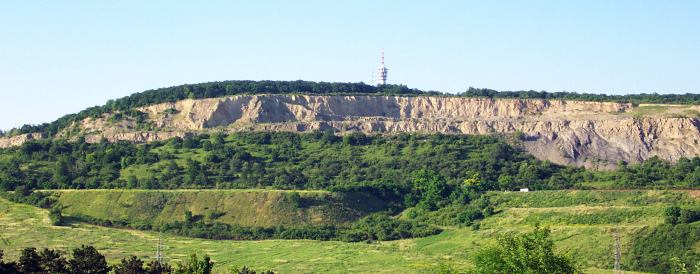
The
Hády hill near Brno
Natural
environment
Geology
Climate
Vegetation
Flora of
vascular plants
Nature
protection
Influence
of human activity
Natural environment
On the northeast border of Brno, which is the second most populated city in the Czech Republic, is located one from landscape dominants – the Hády hill (423 meters above sea level). This limestone headland of the Moravian Karst represents one of the most scientifically interesting areas of the whole region. The nature of this limestone locality, which is the southest spur of the Moravian Karst, is very abundant and protected and endangered plants and animals can usually be found here. The diverse extent of species is portrayed by several facts: The locality is spread on the border of three scientifically quite different areas - Hercynian, Carpathian and Panonian areas, where the high diversity of species supports the presence of lime ground and the influence of the river's phenomena of the deeply cut valley of the Svratka river. The sequence of airplane fotographs is available at
http://www.sci.muni.cz/botany/hady/index.htm
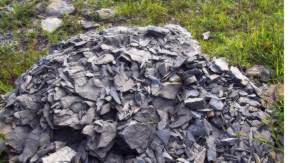 Moravian
Karst is devided into several tectonical plateau. The Hády
hill and its surrounding represents the most southern plateau
from that system finaly modulated by denudation and erosion of
the Svratka and Rícka rivers during the
Jurrasic and Tertiar period. The most lower geological layer of
plateau, Bohemian massif, is here covered by the strong layer
(more than 100 m) of devonian limestones with small sections of
dark shales. Upper part of the plateau bedrock (about 2-5 m)
sedimentated in the time of see overflowing during the Jurrasic
period. Limestone caverns were crowded by maritime sediments from
the upper Tertiary, when the area of Brno was closely
owerflowed by a warm see.
Moravian
Karst is devided into several tectonical plateau. The Hády
hill and its surrounding represents the most southern plateau
from that system finaly modulated by denudation and erosion of
the Svratka and Rícka rivers during the
Jurrasic and Tertiar period. The most lower geological layer of
plateau, Bohemian massif, is here covered by the strong layer
(more than 100 m) of devonian limestones with small sections of
dark shales. Upper part of the plateau bedrock (about 2-5 m)
sedimentated in the time of see overflowing during the Jurrasic
period. Limestone caverns were crowded by maritime sediments from
the upper Tertiary, when the area of Brno was closely
owerflowed by a warm see.
The climate of the Hády Hill is moderately warm and dry. The mean annual temperature at Brno-Turany is 8,7 °C. The warmest month is July with a mean temperature of 18,5 °C, the coldest month January with a mean temperature of -2,5 °C. The mean annual precipitation amounts to 490,1 mm and the time of sunshine duration is 1677,4. More complex information about climate of the Czech Republic is available at http://www.chmi.cz/meteo/ok/infklime.html.
Microclimate conditions differ according to slope, orientation, soil depth and vegetation cover. The Hády plateau covered by deciduous forests has moderately warm temperature conditions. Only its rocky edges (Sumbera rocks) covered by oak and termophilous oak forests maight be microclimatically little warmer and drier, but this situation is also partly affected by human activities during last two centuries. On the other hand, south-facing slopes covered by non-forest vegetation have continental type of microclimate with rather hight differences between extreme temperatures. According to random field measurements, the area of large limestone quarry (see Fig.) seems to be the warmest part of this locality during all vegetation season.
 The prevailing vegetation type on the Hády
plateau is Melampyro nemorosi-Carpinetum with
typical mesophilous species: Asarum europaeum, Campanula
rapunculoides, Convallaria majalis, Dactylis
polygama, Galium odoratum, G. sylvaticum, Polygonatum
multiflorum, Pulmonaria officinalis, Melica uniflora, Poa
nemoralis etc.
The prevailing vegetation type on the Hády
plateau is Melampyro nemorosi-Carpinetum with
typical mesophilous species: Asarum europaeum, Campanula
rapunculoides, Convallaria majalis, Dactylis
polygama, Galium odoratum, G. sylvaticum, Polygonatum
multiflorum, Pulmonaria officinalis, Melica uniflora, Poa
nemoralis etc.
Southern and rocky western margin of the Hády plateau is covered by fragments of thermophilous oak forest (Corno-Quercetum) with Quercus pubescens, Sorbus torminalis, Cornus mas, Crataegus sp. div, Rosa sp. div. and Ligustrum vulgare in the tree and shrub layers, and Brachypodium pinnatum, Centaurea triumfettii, C. michelii, Dactylis polygama, Dictamnus albus, Inula hirta, Lithospermum purpurocaeruleum, Stachys recta, Viola hirta, and Teucrium chamaedrys in the herb layer of the vegetation cover.
The southern edge of Hády plateau and main part of south-facing steep slopes are partly covered with the mosaic of shrub vegetation (the alliance Prunion spinosae and Prunion fruticosae) and dry grasslands of the alliance Bromion erecti and Festucion valesiacae.
Some parts of western slopes with screes are covered by Aceri-Carpinetum with Lamiastrum montanum, Mercurialis perennis, Lathyrus vernus, Geranium robertianum etc. The granodiorit bedrock of ottom parts of the Svitava river valley affect the occurrence of acidophilous oak forests with Luzula luzuloides, Genista tinctoria, Festuca ovina etc.
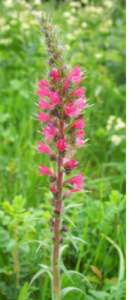 Flora of vascular plants
Flora of vascular plants
The flora of the Hády hill consists of many thermophilous, mesophilous and segetal species typical for the hercynian-panonian border. Xerophilous species occur on steppe remnants of southern slope and they are represented by e. g. Centaurea triumfettii, Stipa joannis, Astragalus danicus, Stipa pulcherrima, Aster amellus, Aster linosyris, Orobanche alba, Thymus pannonicus, Anthericum ramosum, Salvia nemorosa, Polygala major, Peucedanum alsaticum and Pulsatilla grandis. Some Pontic-Pannonian species (Echium russicum, Cytisus procumbens, Linum tenuifolium, Campanula sibirica, Inula ensifolia, Astragalus austriacus, Cirsium pannonicum, Orobanche purpurea) reach their distribution boundary in south-western Moravia.
Mesophilous species of broad-leaved deciduous forests are represented by Lilium martagon, Carex pilosa, Hepatica nobilis, Daphne mezereum, Anemone nemorosa, Euphorbia amygdaloides etc. Western limestone rocky margin of Hády plateau is suitable locality for some other phytogeographically important species - Sesleria varia, Scrophullaria vernalis, Saxifraga tridactylites, Clematis recta, Inula hirta etc.
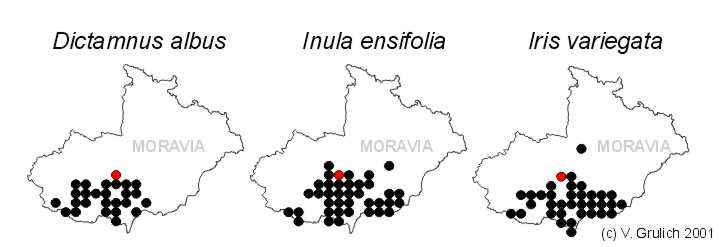
Large fallows of different age are also known from the bottom parts of southern slopes. Some of very interesting weedy species like Lathyrus hirsutus, Nigella arvensis, Sideritis montana, Papaver argemone, Centaurea cyanus, Stachys annua, Orobanche picridis, Ajuga chamaepytis were found through last several years.
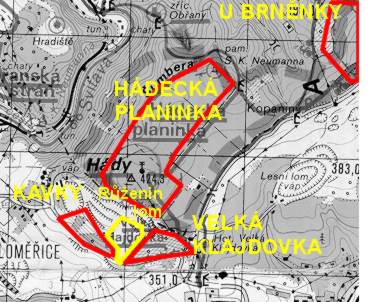 Nature protection
Nature protection
Four remarcable localities (U Brnenky, Hádecká planinka, Kavky, Velká Klajdovka) are protected as natural reserves and fifth (Ruzenin lom) is prepared for official protection. Totaly almost a half of the entire locality Hády is situated in the protected areas and the overall area extends beyond 1 square kilometer. Hády hill is the richest region of endangered plants and insects in wide surroundings. For example, today more than seventy endangered vascular plants (C1-C3 category of the actual Czech Red List) were recorded here, many of them in numerous populations.
Hádecká planinka National Natural Reserve
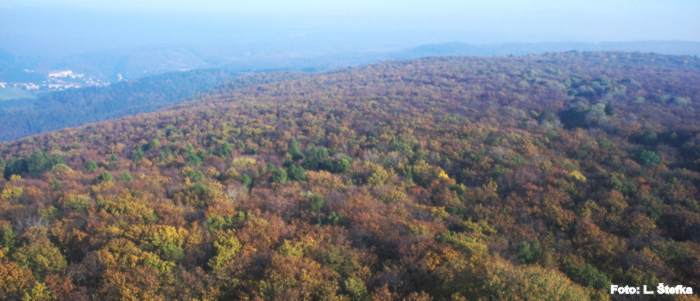
The natural reserve was established in 1950. The area of 79.5 ha protects prevailing part of deciduous oak and oak-hornbeam forests of the Hády plateau. Southern margin of the reserve is botanically and zoologicaly the most interesting part which is covered by patches of thermophilous oak forest and shrub vegetation (alliances Prunion spinosae and Prunion fruticosae) with e. g. Cornus mas, Euonymus verrucosa, Cerasus fruticosa, Rosa pimpinellifolia, Crataegus sp. div. and many endangered herbs occurring there.
Remarcable vascular plants
| Anthericum ramosum Aster amellus Carex humilis Centaurea Triumfettii Cephalanthera damasonium Cerasus fruticosa Cerinthe minor Clematis recta Coralorrhiza trifida Cornus mas Corothamnus procumbens Corydalis solida Cotoneaster integerrimus Daphne mezereum Dictamnus albus Echium russicum Euonymus verrucosa Inula ensifolia Inula hirta Iris variegata Lilium martagon Lithospermum officinale Melampyrum cristatum |
Muscari comosum Orchis ustulata Orobanche alba Orobanche caryophyllea Orobanche pupurea Platanthera bifolia Prunella laciniata Pulmonaria mollissima Pulsatilla grandis Pyrus pyraster Quercus cerris Quercus pubescens Rosa micrantha Rosa pimpinellifolia Saxifraga tridactylites Scrophularia vernalis Sorbus domestica Sorbus torminalis Staphyllea pinnata Stipa joannis Thalictrum minus Thymus pannonicus |
Velká Klajdovka Natural Reserve
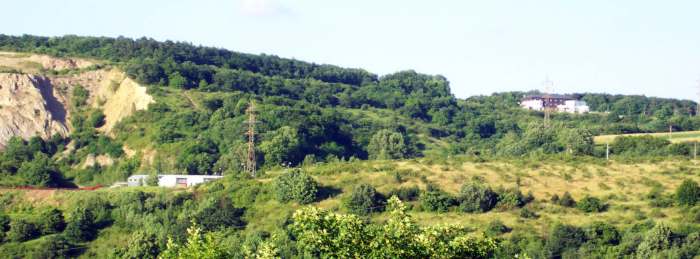
The area of 10 ha protects a mozaic of thermophilous oak forests with Quercus pubescens, Cornus mas and Sorbus torminalis in the tree layer, shrub vegetation and grassland patches. Western part of the protected area is built of limestone bedrock, while the cristalline rocks of Bohemian Massif prevail in the eastern part.
Remarcable vascular plants
| Aster amellus Aster linosyris Carex michelii Centaurea triumfettii Cephalanthera damasonium Cerasus fruticosa Clematis recta Cornus mas Corothamnus procumbens Corothamnus procumbens Cuscuta epithymum Dictamnus albus Euphorbia polychroma Euphorbia virgata Geranium sanguineum |
Chamaecytisus
ratisbonensis Chondrilla juncea Lathyrus latifolius Linaria genistifolia Medicago minima Orchis purpurea Peucedanum cervaria Prunella grandiflora Pyrus pyraster Quercus pubescens Rosa gallica Rosa micrantha Rosa pimpinellifolia Sorbus torminalis Stipa joannis |
U Brnenky Natural Reserve
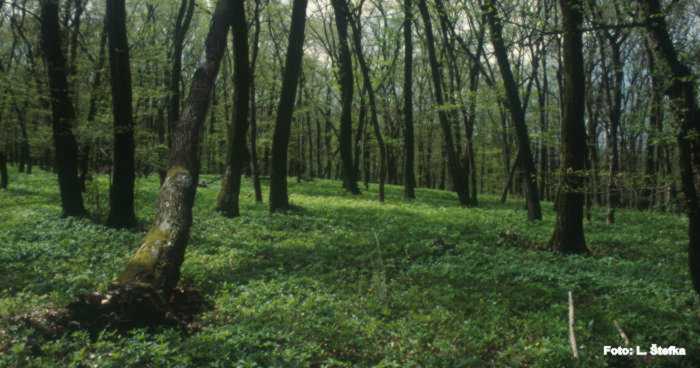
This protected area of about 12 ha was established in 1973 and represents semi-natural deciduous oak-hornbeam forests in the central part of Hády plateau. The vegetation cover has structure similar with the national natural reserve Hádecka planinka. Only eastern part of the reserve has non-forest vegetation at the site of abandoned shallow limestone quarries from nineteenth century.
Remarcable vascular plants
| Anthericum ramosum Aster amellus Cephalanthera damasonium Clematis recta Cornus mas Daphne mezereum Gentiana ciliata Gentiana cruciata |
Lilium martagon Melittis melissophyllum Muscari comosa Peucedanum cervaria Platanthera bifolia Prunella grandiflora Pyrus pyraster Rosa pimpinellifolia |
Kavky Natural Reserve
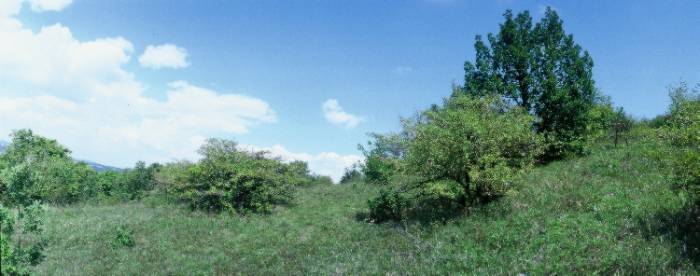
Kavky is the most considerable protected site of the Hády plateau. The hight number of endangered thermophilous species grow just only here, at the area of about 6 ha. The locality has comletely secondary character - Small fields, vineyards and plantations were abandoned before the Second World War and vegetation cover developed in conditions of spontaneous succession which was influenced by existence of steppe remnants in surrounding.
Remarcable vascular plants
| Achillea pannonica Allium rotundum Anemone sylvestris Anthemis austriaca Arabis sagittata Artemisia pontica Aster amellus Campanula glomerata ssp. farinosa Campanula sibirica Carex michelii Cephalanthera damasonium Cerasus fruticosa Cirsium pannonicum Corothamus procumbens Crinitaria linosyris Dictamnus albus Hieracium hoppeanum Chamaepytis chia Inula ensifolia |
Iris variegata Linum tenuifolium Lithospermum officinale Muscari comosum Onobrychis arenaria Orobanche elatiorPeucedanum alsaticum Polygala major Primula veris ssp. canescens Prunella grandiflora Prunella laciniata Pulsatilla grandis Rosa gallica Rosa micrantha Rosa pimpinellifolia Stipa joannis Stipa pulcherrima Thymus glabrescens Tithymalus polychromus |
Ruzenin lom valuable locality (the protection is prepared)
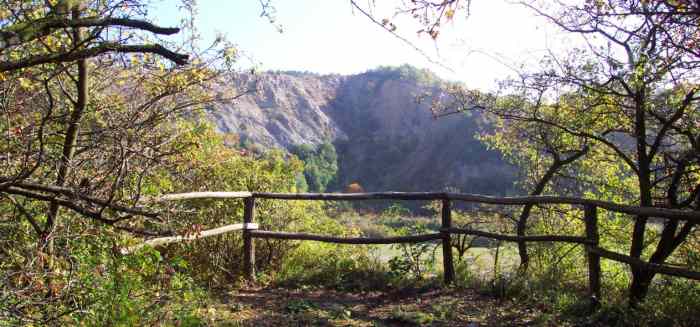
The Růženin lom quarry was utilised as a dump for light ashes from cement production after the end of mining exploitation. However, thanks to a spring of clean water flowing from the quarry's highest face the entire quarry was not filled with waste products. A system of water-holes with a maximum depth of 2 m came into existence on the edge of this new dump. Their banks were soon occupied by some new plants and animals and more significant species immigrated from the surrounding area.
Now about forty endangered plants occur here, among them a numerous population of the orchid Epipactis palustris, subhalophytic Centaurium pulchellum and the last population remnant of the thermophilous Artemisia pontica. A variety of bird songs is heard through the early-morning hours in overgrown sides of the quarry bottom. Besides many different kinds of insects, the water is alive with fish and the snake, Natrix natrix, has found a new home on the stony coast. The area can be characterised as a scenically and ecologically harmonic entity.
Remarcable vascular plants
| Adonis aestivalis Allium flavum Allium montanum Arabis auriculata Artemisia pontica Aster amellus Aster linosyris Campanula sibirica Caucalis platycarpos Centaurium pulchellum Cerasus fruticosa Conringia orientalis Crepis rhoeadifolia Dactylorhiza incarnata Dorycnium germanicum Epipactis palustris Euphrasia tatarica Geranium sanguineum Hippochaete ramosissima Hippochaete X moorei Chamaepitys chia Inula ensifolia Inula hirta |
Lactuca quercina Lactuca viminea Linaria genistifolia Linum tenuifolium Lithospermum purpurocaeruleum Medicago minima Melica ciliata Onobrychis arenaria Polygala major Pseudolysimachion spicatum Quercus pubescens Reseda phyteuma Rosa micrantha Rosa pimpinellifolia Sorbus torminalis Stachys annua Stipa capillata Thesium dollineri Verbascum austriacum Veronica teucrium Vicia pisiformis |
Influence of human activity
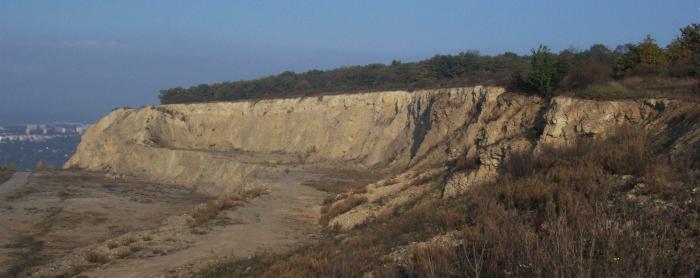
Formerly an agricultural landscape of the southern slope of Hády that was laid with small garden plots, balks, thickets and pastures it gradually started changing its face at the beginning of the twentieth century. However, the most intensive changes have occurred within the last forty years. On the places where the steppe pastures had been, an extensive limestone quarry arose and the former vegetation was pushed back into its marginal areas. Also the city has become larger and two new housing estates with more than 40,000 inhabitants have grown in the close proximity of Hády. Hády and the surrounding areas represent an important opportunity in recreational use for this growing population.
The lime production in the quarry on Hády was terminated in 1998. Since then the site has been gradually recultivated. Without doubt the wide annexation of the land by the quarry has left a deep scar in the natural environment. Fortunately in the close proximity of the quarry the extensive remains of the steppe vegetation have been left untouched. Therefore the quarry has again had a chance to come back to life and become a haven for steppe plants and animals for which the current cultural landscape with modern agriculture is becoming inhabitable.